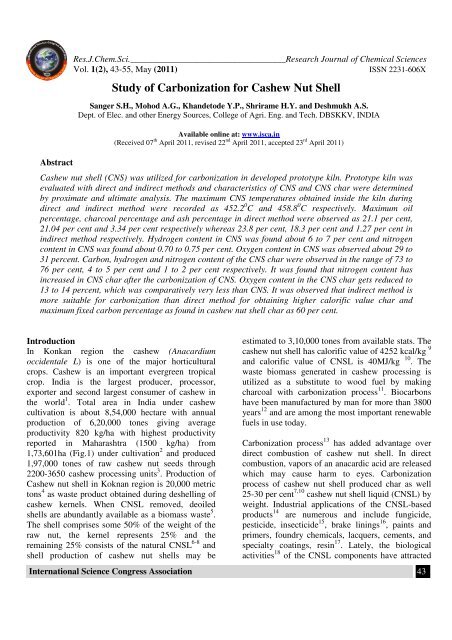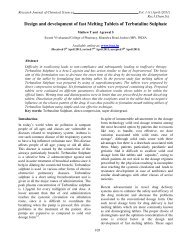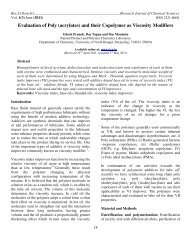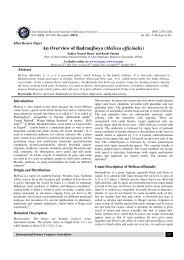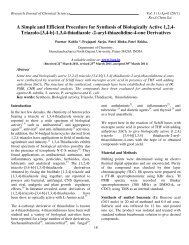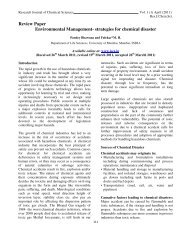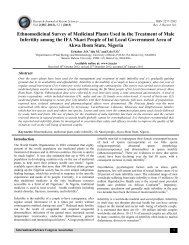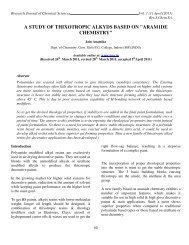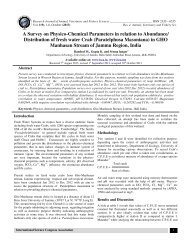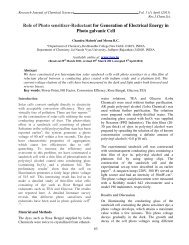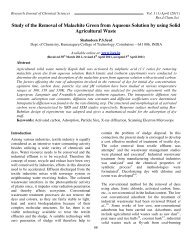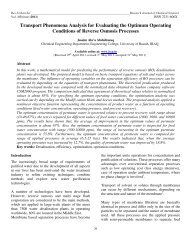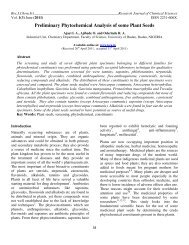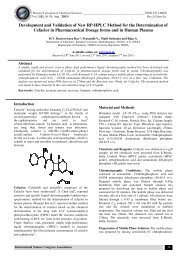Study of Carbonization for Cashew Nut Shell - ISCA
Study of Carbonization for Cashew Nut Shell - ISCA
Study of Carbonization for Cashew Nut Shell - ISCA
You also want an ePaper? Increase the reach of your titles
YUMPU automatically turns print PDFs into web optimized ePapers that Google loves.
Abstract<br />
Res.J.Chem.Sci.___________________________________Research Journal <strong>of</strong> Chemical Sciences<br />
Vol. 1(2), 43-55, May (2011) ISSN 2231-606X<br />
<strong>Study</strong> <strong>of</strong> <strong>Carbonization</strong> <strong>for</strong> <strong>Cashew</strong> <strong>Nut</strong> <strong>Shell</strong><br />
Sanger S.H., Mohod A.G., Khandetode Y.P., Shrirame H.Y. and Deshmukh A.S.<br />
Dept. <strong>of</strong> Elec. and other Energy Sources, College <strong>of</strong> Agri. Eng. and Tech. DBSKKV, INDIA<br />
Available online at: www.isca.in<br />
(Received 07 th April 2011, revised 22 nd April 2011, accepted 23 rd April 2011)<br />
<strong>Cashew</strong> nut shell (CNS) was utilized <strong>for</strong> carbonization in developed prototype kiln. Prototype kiln was<br />
evaluated with direct and indirect methods and characteristics <strong>of</strong> CNS and CNS char were determined<br />
by proximate and ultimate analysis. The maximum CNS temperatures obtained inside the kiln during<br />
direct and indirect method were recorded as 452.2 0 C and 458.8 0 C respectively. Maximum oil<br />
percentage, charcoal percentage and ash percentage in direct method were observed as 21.1 per cent,<br />
21.04 per cent and 3.34 per cent respectively whereas 23.8 per cent, 18.3 per cent and 1.27 per cent in<br />
indirect method respectively. Hydrogen content in CNS was found about 6 to 7 per cent and nitrogen<br />
content in CNS was found about 0.70 to 0.75 per cent. Oxygen content in CNS was observed about 29 to<br />
31 percent. Carbon, hydrogen and nitrogen content <strong>of</strong> the CNS char were observed in the range <strong>of</strong> 73 to<br />
76 per cent, 4 to 5 per cent and 1 to 2 per cent respectively. It was found that nitrogen content has<br />
increased in CNS char after the carbonization <strong>of</strong> CNS. Oxygen content in the CNS char gets reduced to<br />
13 to 14 percent, which was comparatively very less than CNS. It was observed that indirect method is<br />
more suitable <strong>for</strong> carbonization than direct method <strong>for</strong> obtaining higher calorific value char and<br />
maximum fixed carbon percentage as found in cashew nut shell char as 60 per cent.<br />
Introduction<br />
In Konkan region the cashew (Anacardium<br />
occidentale L) is one <strong>of</strong> the major horticultural<br />
crops. <strong>Cashew</strong> is an important evergreen tropical<br />
crop. India is the largest producer, processor,<br />
exporter and second largest consumer <strong>of</strong> cashew in<br />
the world 1 . Total area in India under cashew<br />
cultivation is about 8,54,000 hectare with annual<br />
production <strong>of</strong> 6,20,000 tones giving average<br />
productivity 820 kg/ha with highest productivity<br />
reported in Maharashtra (1500 kg/ha) from<br />
1,73,601ha (Fig.1) under cultivation 2 and produced<br />
1,97,000 tones <strong>of</strong> raw cashew nut seeds through<br />
2200-3650 cashew processing units 3 . Production <strong>of</strong><br />
<strong>Cashew</strong> nut shell in Koknan region is 20,000 metric<br />
tons 4 as waste product obtained during deshelling <strong>of</strong><br />
cashew kernels. When CNSL removed, deoiled<br />
shells are abundantly available as a biomass waste 5 .<br />
The shell comprises some 50% <strong>of</strong> the weight <strong>of</strong> the<br />
raw nut, the kernel represents 25% and the<br />
remaining 25% consists <strong>of</strong> the natural CNSL 6-8 and<br />
shell production <strong>of</strong> cashew nut shells may be<br />
estimated to 3,10,000 tones from available stats. The<br />
cashew nut shell has calorific value <strong>of</strong> 4252 kcal/kg 9<br />
and calorific value <strong>of</strong> CNSL is 40MJ/kg 10 . The<br />
waste biomass generated in cashew processing is<br />
utilized as a substitute to wood fuel by making<br />
charcoal with carbonization process 11 . Biocarbons<br />
have been manufactured by man <strong>for</strong> more than 3800<br />
years 12 and are among the most important renewable<br />
fuels in use today.<br />
<strong>Carbonization</strong> process 13 has added advantage over<br />
direct combustion <strong>of</strong> cashew nut shell. In direct<br />
combustion, vapors <strong>of</strong> an anacardic acid are released<br />
which may cause harm to eyes. <strong>Carbonization</strong><br />
process <strong>of</strong> cashew nut shell produced char as well<br />
25-30 per cent 7,10 cashew nut shell liquid (CNSL) by<br />
weight. Industrial applications <strong>of</strong> the CNSL-based<br />
products 14 are numerous and include fungicide,<br />
pesticide, insecticide 15 , brake linings 16 , paints and<br />
primers, foundry chemicals, lacquers, cements, and<br />
specialty coatings, resin 17 . Lately, the biological<br />
activities 18 <strong>of</strong> the CNSL components have attracted<br />
International Science Congress Association 43
Res.J.Chem.Sci._____________________________________________Research Journal <strong>of</strong> Chemical Sciences<br />
Vol. 1(2), 43-55, May (2011) ISSN 2231-606X<br />
considerable attention in the areas <strong>of</strong> macrolide,<br />
plant growth, acid activity 8 , wood preservative and<br />
pressure treatment activity. Much <strong>of</strong> the biological<br />
activity is attributed to the anacardic acids, which are<br />
the major constituents <strong>of</strong> the cashew nutshells, along<br />
with cardols. However, the major constituents <strong>of</strong> the<br />
technical CNSL, as it is obtained in the current<br />
industrial practice <strong>of</strong> roasting or hot oil bath<br />
methods 19 , are the cardols and cardanols. In the<br />
carbonization process, solid residues with increasing<br />
content <strong>of</strong> carbon element <strong>of</strong> higher activation<br />
energy 20 are <strong>for</strong>med from organic material usually<br />
by pyrolysis in an inert atmosphere. Char<br />
preparation by this method will help in self-reliance<br />
<strong>of</strong> cashew processing unit <strong>for</strong> fuel supply with<br />
higher combustion efficiency. Keeping this view, the<br />
present study was undertaken.<br />
Material and Methods<br />
The cashew nut shell available in the cashew<br />
processing industry was selected as a major raw<br />
material 4 <strong>for</strong> the carbonization process. The<br />
proximate 21,7 and ultimate analysis 3 <strong>of</strong> CNS was<br />
carried out to find out the fuel properties. In addition<br />
to CNS properties, carbonization processes were<br />
studied using metal kiln and tin boxes under direct<br />
and indirect process.<br />
Experimental set up <strong>for</strong> carbonization <strong>of</strong> cashew<br />
nut shell: The carbonization <strong>of</strong> CNS was carried 22<br />
out in developed small capacity single drum kiln 23 ,<br />
which accommodate about 5 kg cashew nut shells.<br />
The kiln (plate 1.a) was designed with 8 mm<br />
diameter holes <strong>for</strong> the per<strong>for</strong>ations with outlet <strong>for</strong> the<br />
oil at the bottom and vent <strong>for</strong> the exhaust at the top<br />
(plate 1c). The size selected was suitable <strong>for</strong> small<br />
amount <strong>of</strong> burning, low cost and fabrication could be<br />
developed locally. Design detail specification <strong>of</strong> kiln<br />
is depicted in table 1. At the beginning, the small<br />
vent at the top and the oil collecting tube at bottom<br />
allowed the burning <strong>of</strong> the cashew nut shells, and<br />
then operated as the pyrolysis mode in a closed kiln<br />
without air. Kiln was evaluated with and without<br />
per<strong>for</strong>ated hole. The selected small capacity kiln was<br />
used <strong>for</strong> direct carbonization process (plate 1.a). The<br />
eight <strong>of</strong> raw CNS was measured and filled the kiln<br />
with full capacity and burn directly. Various<br />
temperatures at different location under kiln, exhaust<br />
temperature <strong>of</strong> vent and oil collected from the<br />
bottom sump were observed periodically. Time<br />
require to complete carbonization process and<br />
amount <strong>of</strong> char remain in kiln was observed at the<br />
end <strong>of</strong> process. The detailed flow chart <strong>of</strong><br />
carbonization processed used is shown in fig.2.<br />
Direct heating method <strong>of</strong> carbonization: Sample<br />
<strong>of</strong> the cashew nut shell was weighed and recorded.<br />
Developed kiln was checked <strong>for</strong> any leakage and<br />
which could not generate heat loss. The wire mesh<br />
grate was kept <strong>for</strong> support at the bottom <strong>of</strong> the kiln.<br />
The height <strong>of</strong> the great support was 6 cm above the<br />
bottom and would act as a convective heat media <strong>for</strong><br />
the partial oxidation process, which would make<br />
heat, flow inside the kiln become more effective.<br />
Kiln was closed after placing the CNS <strong>for</strong> the<br />
carbonization; initial start up firing 24 was done using<br />
loose grass 25 that would transfer the heat to the CNS.<br />
Continuous observations were done to know the<br />
transfer <strong>of</strong> heat; the kiln air inlet size was adjusted<br />
based on the changes observed at the exhaust. Inside<br />
temperature <strong>of</strong> the CNS, outside temperature <strong>of</strong> the<br />
kiln and temperature <strong>of</strong> the exhaust fumes were<br />
recorded <strong>for</strong> the every 60 minutes. The time was<br />
recorded and the carbonization stage changes were<br />
noticed.<br />
The kiln was continuously observed to see the<br />
smoke colour change from blue to light blue, it<br />
found that all the CNS had turned to charcoal;<br />
during that stage the light blue smoke would become<br />
clearer. The kiln was allowed to cool down <strong>for</strong> 8<br />
hours. After that, ash and char were separated,<br />
weighed and recorded.<br />
Indirect heating method <strong>of</strong> carbonization: Two<br />
small tin boxes having 0.3 kg capacity were selected<br />
<strong>for</strong> the indirect heating method <strong>of</strong> the carbonization<br />
(plate 1.b). The hole was made at the center <strong>of</strong> the<br />
tin box lid in order to remove the volatile matter and<br />
moisture associated with it. These tin boxes were<br />
placed inside the kiln and were surrounded by the<br />
cashew nut shells. Sample <strong>of</strong> the cashew nut shell<br />
were weighed and recorded. Prepared kiln was<br />
International Science Congress Association 44
Res.J.Chem.Sci._____________________________________________Research Journal <strong>of</strong> Chemical Sciences<br />
Vol. 1(2), 43-55, May (2011) ISSN 2231-606X<br />
checked <strong>for</strong> any leakage and which could generate<br />
heat loss. The wire mesh grate was kept <strong>for</strong> support<br />
at the bottom <strong>of</strong> the kiln; the height <strong>of</strong> the great<br />
support was 6 cm above the bottom and would act as<br />
a convective heat media <strong>for</strong> the partial oxidation<br />
process, which would make heat, flow inside the kiln<br />
become more effective. Kiln was closed after<br />
placing the CNS <strong>for</strong> the carbonization; initial start up<br />
firing was done using wood chips that will transfer<br />
the heat to the CNS. Continuous observations were<br />
done to know the transfer <strong>of</strong> heat; the kiln air inlet<br />
size was adjusted based on the changes observed at<br />
the exhaust. Inside temperature <strong>of</strong> the CNS, outside<br />
temperature <strong>of</strong> the kiln and temperature <strong>of</strong> the<br />
exhaust fumes was recorded <strong>for</strong> the every 60<br />
minutes. Recorded the time and the carbonization<br />
stage changes were observed.<br />
The kiln was continuously observed <strong>for</strong> colour<br />
change <strong>of</strong> the smoke from blue to light blue as it<br />
direct heating method.<br />
Proximate analysis <strong>of</strong> CNS and its char:<br />
Determination <strong>of</strong> moisture content: About 1g <strong>of</strong><br />
finely powdered air-dried sample was weighed in a<br />
crucible. The crucible was placed inside an electric<br />
hot air-oven, maintained at 105 0 C. The crucible was<br />
allowed to remain in oven <strong>for</strong> 1 hour and then taken<br />
out (with the help <strong>of</strong> a pair <strong>of</strong> tongs), cooled in<br />
desiccators and weighed. Loss in weight (ASTMD-<br />
3173) was reported as moisture (on percentagebasis).<br />
(26)<br />
w2<br />
− w3<br />
Moisture content, (% wb) = × 100<br />
w − w<br />
Where, w1 = weight <strong>of</strong> crucible, g<br />
w2 = weight <strong>of</strong> crucible + sample, g<br />
w3 = weight <strong>of</strong> crucible + sample, after heating, g<br />
Determination <strong>of</strong> volatile matter volatile matter:<br />
Volatile matter was determined by keeping the dried<br />
sample in a closed crucible at 600 0 C <strong>for</strong> six minutes<br />
and then at 900 0 C <strong>for</strong> another six minutes (ASTMD-<br />
3275). The difference in the weight duo to loss <strong>of</strong><br />
volatiles was taken as the total volatile matter<br />
2<br />
1<br />
present in the biomass. Loss in weight was reported<br />
as volatile matter on percentage basis.<br />
w5<br />
− w6<br />
Volatile matter (%) = × 100<br />
w5<br />
− w1<br />
Where,<br />
w4 = weight <strong>of</strong> crucible + weight <strong>of</strong> sample be<strong>for</strong>e<br />
oven drying, g<br />
w5 = weight <strong>of</strong> crucible + weight <strong>of</strong> sample be<strong>for</strong>e<br />
keeping in muffle furnace, g<br />
w6 = weight <strong>of</strong> crucible + weight <strong>of</strong> sample after<br />
keeping in muffle furnace, g<br />
Determination <strong>of</strong> ash content: The residual coal in<br />
the crucible in 2 was then heated without lid in a<br />
muffle furnace at 750 0 C <strong>for</strong> half hour <strong>for</strong> (ASTMD-<br />
3174). The crucible was then taken out, cooled first<br />
in air, then in desiccators and weighed. Heating,<br />
cooling and weighing was repeated, till a constant<br />
weight was obtained. The residue was reported as<br />
ash on percentage-basis.<br />
w8<br />
− w9<br />
Ash content, (%) = × 100<br />
w − w<br />
Where,<br />
w7 = weight <strong>of</strong> crucible + weight <strong>of</strong> sample be<strong>for</strong>e<br />
oven drying, g<br />
w8 = weight <strong>of</strong> crucible + weight <strong>of</strong> sample be<strong>for</strong>e<br />
keeping in muffle furnace, g<br />
w9 = weight <strong>of</strong> crucible + weight <strong>of</strong> sample after<br />
keeping in muffle furnace, g<br />
Determination <strong>of</strong> fixed carbon: The fixed carbon<br />
in percentage was calculated by difference.<br />
Fixed carbon (%) = 100 – % <strong>of</strong> (moisture content +<br />
volatile matter +ash)<br />
Procedure <strong>for</strong> determination <strong>of</strong> calorific value <strong>of</strong><br />
the fuel by using the Oxygen Bomb Calorimeter:<br />
A known mass <strong>of</strong> the given sample was taken in<br />
clean crucible. The crucible was then supported over<br />
the ring. A fine magnesium wire, touching the fuel<br />
sample, was then stretched across the electrodes. The<br />
bomb lid was tightly screwed and bomb filled with<br />
oxygen 25 atmospheric pressure. The bomb was then<br />
lowered into copper calorimeter, containing a known<br />
mass <strong>of</strong> water. The stirrer was worked and initial<br />
temperature <strong>of</strong> the water was noted. The electrodes<br />
International Science Congress Association 45<br />
7<br />
1
Res.J.Chem.Sci._____________________________________________Research Journal <strong>of</strong> Chemical Sciences<br />
Vol. 1(2), 43-55, May (2011) ISSN 2231-606X<br />
are then connected to 6-volt battery and circuit<br />
completed. The sample burns and heat was liberated.<br />
Uni<strong>for</strong>m stirring <strong>of</strong> water was continued and the<br />
maximum temperature attained was recorded, the<br />
experimental setup <strong>for</strong> determination <strong>of</strong> calorific<br />
value using Bomb calorimeter.<br />
The calorific value <strong>of</strong> the CNS and its char was<br />
determined by using Bomb Calorimeter. The<br />
calorific value <strong>of</strong> the CNS and its char was<br />
determined by using the following <strong>for</strong>mula 26 .<br />
( W + w)<br />
× ( T1<br />
− T2<br />
)<br />
Calorific value (kcal/kg) =<br />
X<br />
Where,<br />
W = weight <strong>of</strong> water in calorimeter (kg),<br />
w = water equivalent <strong>of</strong> apparatus,<br />
T1 = initial temperature <strong>of</strong> water ( 0 C),<br />
T2 = final temperature <strong>of</strong> water ( 0 C),<br />
X = weight <strong>of</strong> fuel sample taken (kg)<br />
Ultimate analysis <strong>of</strong> CNS and char: Carbon,<br />
hydrogen, oxygen, nitrogen, and sulphur content <strong>of</strong><br />
CNS and its char were found out under the ultimate<br />
analysis. The ultimate analysis is helpful in<br />
calculating heat balances in any process in which<br />
coal is used as fuel. Using the values <strong>of</strong> proximate<br />
analysis, ultimate analysis <strong>of</strong> CNS char could be<br />
done theoretically by using the various <strong>for</strong>mulas 27 .<br />
Calculation <strong>of</strong> C, H, N and O from the proximate<br />
analysis: These values were carried out through the<br />
following steps 27 .<br />
Determination <strong>of</strong> carbon content: Carbon content<br />
<strong>of</strong> the sample was calculated theoretically on the<br />
basis <strong>of</strong> following <strong>for</strong>mula,<br />
C = 0.97 FC + 0.7 (VM – 0.1 A) – M (0.6 – 0.01 M), %<br />
Determination <strong>of</strong> hydrogen content: Hydrogen<br />
content <strong>of</strong> the sample was calculated theoretically<br />
which was given by,<br />
N2 = 2.10 – 0.020 VM, %<br />
Determination <strong>of</strong> oxygen content: Oxygen content<br />
<strong>of</strong> the sample was calculated theoretically by<br />
difference on the basis <strong>of</strong> the following <strong>for</strong>mula,<br />
O2 = 100 - % <strong>of</strong> (C + H + N + Ash), %<br />
Where, FC = fixed carbon, %<br />
A = ash, %<br />
VM = volatile matter, %<br />
M = moisture, %<br />
Results and Discussion<br />
CNS was selected as a biomass <strong>for</strong> carbonization<br />
because CNS was treated as waste in Konkan region<br />
and it is abundantly available in this region. Bulk<br />
density <strong>of</strong> CNS was 481.83 kg/m 3 , calorific value<br />
was nearly about 5000 kcal/kg and oil content was<br />
about 20 to 25 percent. The calorific values and oil<br />
content values were observed similar to values<br />
observed by Ramanan in 2008.<br />
<strong>Carbonization</strong> <strong>of</strong> CNS: In the carbonization<br />
process, solid residues with increasing content <strong>of</strong> the<br />
element carbon were <strong>for</strong>med from the organic<br />
material usually by pyrolysis in an inert atmosphere.<br />
Char preparation by this method would help in self<br />
reliance <strong>of</strong> cashew processing unit <strong>for</strong> fuel supply<br />
with higher combustion efficiency. The<br />
carbonization process <strong>of</strong> CNS was carried out in<br />
direct and indirect ways, which results into the<br />
production <strong>of</strong> charcoal (Plate 1 d) as the main<br />
product plus gaseous product along with the CNSL<br />
(Plate 1 e) and ash. For thorough study <strong>of</strong> the<br />
carbonization process, shell temperature inside the<br />
kiln, exhaust temperature at the top vent and the<br />
outside temperature <strong>of</strong> the cylinder were recorded.<br />
The temperatures recorded in the direct and indirect<br />
method are shown below in the graphical <strong>for</strong>mat in<br />
fig. 3 and fig. 4 respectively.<br />
H = 0.036 FC + 0.086 (VM – 0.1 A) – 0.0035 M<br />
International Science Congress Association 46<br />
2 (1 – 0.02 M), % It was observed from the fig. 3 and fig. 4 that time<br />
required to reach maximum temperature inside the<br />
Determination <strong>of</strong> nitrogen content: Nitrogen kiln using indirect method was comparatively less<br />
content <strong>of</strong> the sample was calculated theoretically than direct method <strong>for</strong> obtaining CNS char.<br />
which was given by,<br />
maximum temperature was achieved in indirect
Res.J.Chem.Sci._____________________________________________Research Journal <strong>of</strong> Chemical Sciences<br />
Vol. 1(2), 43-55, May (2011) ISSN 2231-606X<br />
method in less time while direct method took more<br />
time <strong>for</strong> the carbonization. This may happen due as<br />
temperature <strong>of</strong> dried fuel was evaluated to about<br />
225-325 0 C, pyrolysis <strong>of</strong> hemicelluloses begins,<br />
cellulose gets pyrolysed at a temperature range <strong>of</strong><br />
325 0 C –375 0 C while legnin starts pyrolysing at a<br />
temperature range <strong>of</strong> 350-500 0 C 28 . Pyrolysis gases<br />
escape and char layer is <strong>for</strong>m on fuel particle. It<br />
could be observed, in both methods, inside<br />
temperature varies more drastically than outside<br />
exhaust temperatures. Average temperature <strong>of</strong> shell<br />
at core part <strong>of</strong> kiln varies from 86 0 C to 445 0 C in<br />
direct method whereas it varies from 80 0 C to 448 0 C<br />
in indirect method. Average exhaust temperature at<br />
the top vent varies from 172 0 C to 218 0 C in direct<br />
method while it varies from 175 0 C to 230 0 C in<br />
indirect method. Average outside temperature <strong>of</strong> the<br />
kiln was recorded in the range <strong>of</strong> 44 0 C to 60 0 C <strong>for</strong><br />
direct method and 45 0 to 61 0 C <strong>for</strong> indirect method. It<br />
was also observed that smoke colour gradually<br />
changes from blackish to white and then from white<br />
to colourless when all CNS turned to charcoal at the<br />
temperature 350 0 C onwards in both the methods.<br />
Similarly, <strong>for</strong> comparing between the direct and<br />
indirect method, char percentage, oil percentage and<br />
ash percentage were observed and recorded which is<br />
shown graphically in fig. 5, fig. 6 and fig. 7<br />
respectively.<br />
From the fig. 5, fig. 6 and fig. 7, it was observed that<br />
char and ash percentage obtained in direct method<br />
was more than indirect method and oil percentage<br />
obtained in direct plus indirect method was more<br />
compared to direct method. Maximum oil<br />
percentages obtained in direct and direct plus<br />
indirect method were recorded as 21.1 per cent and<br />
23.8 per cent respectively. Properties <strong>of</strong> CNSL like<br />
flash and fire point; viscosity, pH and calorific value<br />
were determined (table 2) <strong>for</strong> safe handling, storage<br />
and use <strong>of</strong> CNSL on commercial scale.<br />
In direct method, maximum char and ash<br />
percentages were recorded as 21.04 per cent and<br />
3.34 per cent respectively while in case <strong>of</strong> indirect<br />
method these values were recorded as 18.45 per cent<br />
and 1.27 per cent respectively. Charcoal obtained in<br />
indirect method was comparatively low than direct<br />
method but had more calorific value reason being<br />
higher temperature while heating <strong>of</strong> partial at lower<br />
rate to lower ultimate temperature favors char<br />
<strong>for</strong>mation 29 . Ash obtained in indirect method was<br />
observed less than that <strong>of</strong> direct method. This<br />
happened due to the reason that flame did not come<br />
in direct contact with CNS in indirect method.<br />
Since, ash obtained was less in indirect method; it is<br />
there<strong>for</strong>e indirect method considered as more<br />
suitable <strong>for</strong> carbonization <strong>of</strong> CNS.<br />
Char obtained from prototype kiln was tested in<br />
improved chulhas <strong>for</strong> water boiling test. Most things<br />
are found, while burning the char (Plate 1.f) <strong>of</strong><br />
cashew nut shell smoke was not produced as<br />
produced by burning the raw cashew nut shell in<br />
same chulhas.<br />
Proximate analysis <strong>of</strong> CNS and its char:<br />
Proximate analysis 30 <strong>of</strong> CNS and its char <strong>for</strong><br />
determination <strong>of</strong> moisture content, volatile matter,<br />
ash content and fixed carbon was carried out.<br />
Calorific value <strong>of</strong> the raw material was determined<br />
using standard procedure. The results <strong>of</strong> proximate<br />
analysis and calorific value are shown in figure 8<br />
and figure 9 respectively.<br />
From the figure 8, it was observed that moisture<br />
content <strong>of</strong> the CNS varies from 10 to 11% while<br />
moisture content in char varies from 5 to 6 %. For<br />
CNS the volatile matter observed in the range from<br />
65 to 70% while in char varies from 25 to 30%. It<br />
could also be observed that ash content in the CNS<br />
sample was less than that <strong>of</strong> the CNS char. After<br />
carbonization fixed carbon percentage was found<br />
considerably increased in CNS char.<br />
From the figure 9, it was observed that maximum<br />
calorific value <strong>of</strong> char obtained in direct method was<br />
calculated as 6474.6 kcal/kg and char obtained in<br />
indirect method has maximum calorific value 6714.8<br />
kcal/kg. Char obtained in indirect method was more<br />
superior to the char obtained in direct method due to<br />
its high calorific value 31 .<br />
International Science Congress Association 47
Res.J.Chem.Sci._____________________________________________Research Journal <strong>of</strong> Chemical Sciences<br />
Vol. 1(2), 43-55, May (2011) ISSN 2231-606X<br />
Ultimate analysis <strong>of</strong> CNS and its char: The<br />
ultimate analysis <strong>of</strong> CNS and its char was carried out<br />
in order to determine its carbon, hydrogen and<br />
oxygen and nitrogen percentage. Ultimate analysis<br />
<strong>of</strong> the given sample was carried out theoretically<br />
from the results obtained in proximate analysis.<br />
Ultimate analysis <strong>of</strong> the given sample could be<br />
carried out theoretically on the basis <strong>of</strong> <strong>for</strong>mulae.<br />
The results <strong>of</strong> ultimate analysis <strong>of</strong> CNS and CNS<br />
char are shown graphically in figure10.<br />
From the figure 10 (a), it was found that carbon<br />
percentage in the CNS was in the range <strong>of</strong> 60 to 62<br />
percent. Hydrogen content in CNS was found about<br />
6 to 7 per cent and nitrogen content in CNS was<br />
found about 0.70 to 0.75 per cent. Oxygen content in<br />
CNS was observed about 29 to 31 percent.<br />
Similarly, from the figure 10 (b), carbon, hydrogen<br />
and nitrogen content <strong>of</strong> the CNS char were observed<br />
in the range <strong>of</strong> 73 to 76 per cent, 4 to 5 per cent and<br />
1 to 2 per cent respectively. It was found that<br />
nitrogen content has increased in CNS char after the<br />
carbonization <strong>of</strong> CNS. Oxygen content in the CNS<br />
char gets reduced to 13 to 14 percent, which was<br />
comparatively very less than CNS.<br />
Mass and Energy balance: Actual amount <strong>of</strong> CNS<br />
char obtain in direct combustion after thermal<br />
decomposition in kiln comparing to raw CNS<br />
material was low but while analyzing carbon<br />
balancing depicted in figure 10 shows actual<br />
utilization <strong>of</strong> carbon was 28 % and it get lost 28.4 %<br />
carbon in exhaust gases, 17 % kg carbon in<br />
condensate, 0.6 kg in ash and remaining 26 % is un<br />
burn. That many losses occurred in condensate and<br />
exhaust gases due to evaporation <strong>of</strong> moisture and<br />
<strong>for</strong>mation <strong>of</strong> CNSL oil, which required 2.8 MJ <strong>of</strong><br />
energy to drive out one kilogram <strong>of</strong> moisture in<br />
fuel 32 .<br />
rest <strong>of</strong> 23 % lost in exhaust, 14 % in condensate, 17<br />
% in un burnt char and 14 % energy losses found as<br />
unaccounted.<br />
Conclusions<br />
It was observed that indirect method is more suitable<br />
<strong>for</strong> carbonization than direct method <strong>for</strong> higher<br />
calorific value char. It was observed that time<br />
required <strong>for</strong> the carbonization using indirect method<br />
was comparatively less than direct method.<br />
It was observed that maximum fixed carbon<br />
percentage found in cashew nut shell char as 60 per<br />
cent.<br />
Acknowledgements<br />
Authors are highly thankful to Department <strong>of</strong><br />
Electrical and Other Energy Sources, College <strong>of</strong><br />
Agricultural Engineering and Technology,<br />
DBSKKV, Dapoli <strong>for</strong> giving the facility to carry out<br />
research work.<br />
References<br />
1. http://www.cashewindia.org.<br />
2. Haldankar P.M., Haldvnkar P.C., Govekar M.S.<br />
and Mali P.C., <strong>Cashew</strong> research and<br />
development in Konkan region <strong>of</strong> Maharashtra,<br />
Proceeding <strong>of</strong> National seminar on research,<br />
development and marketing <strong>of</strong> cashew, Goa, 33-<br />
35 (2007)<br />
3. Anonymous <strong>Cashew</strong> production technology.<br />
Technical Note, National Research Center <strong>for</strong><br />
<strong>Cashew</strong>, ICAR, Puttur, Karnataka, 12-34 (2009)<br />
4. Mohod Atul, Jain Sudhir and Powar A.G.,<br />
Energy option <strong>for</strong> small-scale cashew nut<br />
processing in India, Energy Research Journal, 1,<br />
47-50 (2010)<br />
There is large unaccounted heat loses due to several<br />
factor as heat energy loss itself due to the kiln heat<br />
losses in terms <strong>of</strong> startup energy as well as heat<br />
losses<br />
International Science Congress Association 48<br />
13 in direct combustion. The energy balance<br />
predicted the share <strong>of</strong> energy was 31 % in CNS char,<br />
5. Belen B. Bisana and Nieva B. Laxamana,<br />
Utilization <strong>of</strong> cashew nut shell residue <strong>for</strong><br />
charcoal briquettes and activated carbon<br />
production, Journal <strong>of</strong> Wood Science, 44, 56-61<br />
(2008)
Res.J.Chem.Sci._____________________________________________Research Journal <strong>of</strong> Chemical Sciences<br />
Vol. 1(2), 43-55, May (2011) ISSN 2231-606X<br />
6. Rajapakse R.A., Gunatillakeand P.A. and<br />
Wijekoon K.B., A Preliminary study on<br />
processing <strong>of</strong> cashew-nuts and production <strong>of</strong><br />
cashew nut shell liquid (CNSL) on a commercial<br />
scale in Sri Lanka, J. Ntn. Sci. Coun., 5(2), 117-<br />
124 (1977)<br />
7. Venkata Ramanan M., Lakshmanan E.,<br />
Sethumadhavan R. and Renganarayanan S.,<br />
Per<strong>for</strong>mance prediction and validation <strong>of</strong><br />
equilibrium modeling <strong>for</strong> Gasification <strong>of</strong> cashew<br />
nut shell char, Brazilian Journal <strong>of</strong> Chemical<br />
Engineering, 25(3), 585-601 (2008)<br />
8. Maria Lucilia dos Santos and Gouvan C. de<br />
Magalhães, Utilisation <strong>of</strong> <strong>Cashew</strong> <strong>Nut</strong> <strong>Shell</strong><br />
Liquid from Anacardium occidentale as Starting<br />
Material <strong>for</strong> Organic Snthesis: A Novel Route to<br />
Lasiodiplodin from Cardols, J. Braz. Chem. Soc.,<br />
10(1), 13-20, (1999)<br />
9. Tsamba Yang Weihong and Wlodzimierz<br />
Blasiak, Pyrolysis characteristics and global<br />
kinetics <strong>of</strong> coconut and cashew nut shells, Fuel<br />
Processing Technology, 87, 523-530 (2006)<br />
10. Das Piyali and Ganesh Anuradda, Bio-oil from<br />
pyrolysis <strong>of</strong> cashew nut shell-a near fuel,<br />
Biomass and Bioenergy, 25, 113-117 (2003)<br />
11. Das Piyali, Sreelatha T. and Anuradda G., Biooil<br />
from pyrolysis <strong>of</strong> cashew nut shell<br />
characterization and related properties, Biomass<br />
and Bioenergy, 27, 265-275 (2004)<br />
12. Bard, E.Science, 292, 2443-2444 (2001)<br />
13. Kampegowda Rajesh and Chandayot Pongchan,<br />
Slow pyrolysis <strong>for</strong> rural small biomass energy by<br />
joint project development in Brazil and Thailand<br />
(2007) www.asianust.ac.th, 1-17.<br />
14. Mathew Obichukwu, Labake and Ngozi Rita,<br />
Extraction <strong>of</strong> Polyphenols from <strong>Cashew</strong> <strong>Nut</strong><br />
<strong>Shell</strong>, Leonardo Electronic Journal <strong>of</strong> Practices<br />
and Technologies, 9, 107-112 (2006)<br />
15. Behrens R., <strong>Cashew</strong> as an Agr<strong>of</strong>orestry Crop,<br />
Tropical Agriculture, Margraf Verlag,<br />
Weikersheim, Germany (1996)<br />
16. Lubi M.C. and Thachil E.T., <strong>Cashew</strong> nut shell<br />
liquid (CNSL)- a versatile monomer <strong>for</strong> polymer<br />
synthesis, International journal <strong>of</strong> polymeric<br />
materials, 3(2), 123-153 (2000)<br />
17. Oghome P. and Kehinde A.J., Separation <strong>of</strong><br />
<strong>Cashew</strong> <strong>Nut</strong> <strong>Shell</strong> Liquid by column<br />
Cromatography, African Journal <strong>of</strong> Science and<br />
Technology, Science and engineering, 5(2), 92-<br />
95(2000)<br />
18. Shobha S.V. and Ravindranath B., Supercritical<br />
Carbon Dioxide and Solvent Extraction <strong>of</strong> the<br />
Phenolic Lipids <strong>of</strong> <strong>Cashew</strong> <strong>Nut</strong> (Anacardium<br />
occidentale) <strong>Shell</strong>s., J. Agric. Food Chem., 39,<br />
2214-2217 (1991)<br />
19. Tyman J.H.P., In Studies in Natural Products<br />
Chemistry, Atta-ur-Rahan, Ed., Elsevier Science<br />
Publisher, Amsterdam, 9, 313 (1991)<br />
20. Ro K.S., Cantrell K.B., Hunt P.G., Ducey T. F.<br />
Vanotti M.B. and Szogi A.A., Thermo chemical<br />
conversion <strong>of</strong> livestock waste: carbonization <strong>of</strong><br />
swine solids, Journal <strong>of</strong> bioresearch Technology<br />
, 100, 5466-5471, (2009)<br />
21. Singh R.N., Jena U., Patel J.B. and Sharma A.<br />
M., Feasibility study <strong>of</strong> cashew nut shell as an<br />
open core gasifier feedstock, Renewable Energy,<br />
31, 481-487 (2006)<br />
22. Anonymous, AMM, Murugappa Chettiar<br />
Research Center Taramani, Chenai, 3-4 (2008)<br />
23. Sjoerd Nienhuys Ing., The Beehive Charcoal<br />
Briquette Stove in the Khumbu Region, Nepal,<br />
6-7 (2003)<br />
24. Jenkins B.M., Baxter L.L., Miles J and Miles<br />
T.R., Combustion properties <strong>of</strong> biomass, Fuel<br />
processing Technology, 54, 17-46 (1998)<br />
International Science Congress Association 49
Res.J.Chem.Sci._________________________________________<br />
Res.J.Chem.Sci._____________________________________________Research __Research Journal <strong>of</strong> Chemical Sciences<br />
Vol. 1(2), 43-55, May (2011)<br />
ISSN 2231-606X<br />
25. Quaak P, Knowf H, and Stassen H. H., Energy from<br />
biomass: a review <strong>of</strong> combustion and<br />
gasification asification technologies, World Bank Technical<br />
paper Series No. 422, Washing Washington, DC: The<br />
World Bank, 178 (1999)<br />
26. Dara S.S., A practical handbook <strong>of</strong> Engineering<br />
Chemistry, 60-62 (1999)<br />
27. Anonymous, Notes from rom Bureau <strong>of</strong> Energy<br />
Efficiency (2008)<br />
28. Shafizadeh F. and Chin P.S. P.S., Thermal<br />
deterioration <strong>of</strong> Wood, In wood technology:<br />
chemistry aspects, edited by I S Goldstein Gol<br />
Washington, DC:ACS press, 57-81 81 (1997)<br />
29. Wenzl H., Rates <strong>of</strong> coal pyrolysis and<br />
gasification reactions. In coal conversion<br />
technology, edited by C.Y. Y. Wen and E.S. Lee,<br />
57-170 (1970)<br />
30. Curvers A. and Gigler J.K., Characterization <strong>of</strong><br />
biomass fuel, an inventory <strong>of</strong> standard procedure<br />
<strong>for</strong> the determination <strong>of</strong> biomass properties, properties<br />
ECN-C-96-032, 66 (1996)<br />
31. Cordero T., Marquez F., , Rodriguez-Mirasol Rodriguez J.<br />
and Rodriguez J.J., Predicting heating values <strong>of</strong><br />
lignocelluloses and carbonaceous materials fr from<br />
proximate analysis, Fuel, 80, 1567 1567-1571 (2001)<br />
32. Kishor V.V.V.N., Renewable Energy<br />
Engineering and Technology, , Published by<br />
TERI Press, New Delhi, 717 (2008)<br />
Table-1: 1: Overall dimensions <strong>of</strong> kiln<br />
Particular Dimensions<br />
A) Kiln cylinder<br />
1. Total height<br />
2. Diameter<br />
51cm<br />
30cm<br />
International Science Congress Association<br />
3. Thickness<br />
4. Diameter <strong>of</strong> bottom 0.5cm<br />
vent<br />
5. Material<br />
Mild steel<br />
B) Kiln lid<br />
1. Total height<br />
2. Diameter<br />
3. Thickness<br />
4.Diameter <strong>of</strong> top vent 0.8 cm<br />
5.Air required <strong>for</strong> 5 kg<br />
shell<br />
6.<br />
shell<br />
6. No.<br />
combustion<br />
<strong>of</strong> vents provided 16<br />
7.Time required<br />
8. Material<br />
C) Overall height <strong>of</strong> kiln 52 cm<br />
Table- 2: Properties <strong>of</strong> cashew nut shell oil<br />
Properties<br />
Flash point<br />
Fire point<br />
pH<br />
Calorific Value<br />
Viscosity at 33 0 C<br />
Viscosity at 43 0 C<br />
Bulk density<br />
Distribution <strong>of</strong> (173601ha) area under cashew<br />
in Konkan<br />
89999<br />
19088<br />
Thane<br />
1cm<br />
2.5cm<br />
31cm<br />
1cm<br />
25m 3<br />
13 hours<br />
Mild steel<br />
Value <strong>of</strong> the CNSL<br />
114 0 C<br />
118 0 C<br />
5.7<br />
1053 cal/gm<br />
C 693 Redwood<br />
C 480 Redwood<br />
0.957 gm/cc<br />
10783<br />
Raigad<br />
53731<br />
50
Res.J.Chem.Sci._____________________________________________Research Journal <strong>of</strong> Chemical Sciences<br />
Vol. 1(2), 43-55, May (2011) ISSN 2231-606X<br />
Figure-1: Area under cashew cultivation in<br />
Konkan region <strong>of</strong> Maharashtra<br />
Temperature ( o C)<br />
500<br />
450<br />
400<br />
350<br />
300<br />
250<br />
200<br />
150<br />
100<br />
50<br />
0<br />
Figure-2: Process flow chart <strong>of</strong> carbonization<br />
methods<br />
1 2 3 4 5 6 7 8 9 10 11 12 13 14 15<br />
Time (hour)<br />
Figure-3: Variation <strong>of</strong> carbonization temperature with time during direct method<br />
Temperature ( o C)<br />
500<br />
400<br />
300<br />
200<br />
100<br />
0<br />
<strong>Shell</strong> temp. at core part <strong>of</strong> kiln<br />
Outside temp. <strong>of</strong> kiln<br />
Exhaust temp. at top vent<br />
<strong>Shell</strong> temp. at core part <strong>of</strong> kiln<br />
Outside temp. <strong>of</strong> kiln<br />
Exhaust temp. at top vent<br />
1 2 3 4 5 6 7 8 9 10 11 12 13<br />
Time (hour)<br />
Figure-4: Variation <strong>of</strong> carbonization temperature with time during indirect method<br />
International Science Congress Association 51
Res.J.Chem.Sci._____________________________________________Research Journal <strong>of</strong> Chemical Sciences<br />
Vol. 1(2), 43-55, May (2011) ISSN 2231-606X<br />
Percentage, (%)<br />
Percentage, (%)<br />
25<br />
20<br />
15<br />
10<br />
5<br />
0<br />
1 2 3<br />
Figure-5: Comparison <strong>of</strong> direct and indirect method <strong>for</strong> char percentage<br />
25<br />
20<br />
15<br />
10<br />
5<br />
0<br />
Char obtained in direct method Char obtained in indirect method<br />
<strong>Cashew</strong>q nut shell samples<br />
1 2 3<br />
<strong>Cashew</strong> nut shell sample<br />
Figure-6: Comparison <strong>of</strong> direct and direct plus indirect method <strong>for</strong> oil percentage<br />
Percentage, (%)<br />
Oil obtained in direct method Oil obtained in direct plus indirect method<br />
4<br />
3.5<br />
3<br />
2.5<br />
2<br />
1.5<br />
1<br />
0.5<br />
0<br />
Ash obtained in direct method Ash obtained in indirect method<br />
1 2 3<br />
<strong>Cashew</strong> nut shell samples<br />
International Science Congress Association 52
Res.J.Chem.Sci._____________________________________________Research Journal <strong>of</strong> Chemical Sciences<br />
Vol. 1(2), 43-55, May (2011) ISSN 2231-606X<br />
Cal. value (kcal/kg)<br />
Percentage, (%)<br />
Percentage, (%)<br />
70<br />
60<br />
50<br />
40<br />
30<br />
20<br />
10<br />
80<br />
70<br />
60<br />
50<br />
40<br />
30<br />
20<br />
10<br />
0<br />
Figure-7: Comparison <strong>of</strong> direct and indirect method <strong>for</strong> ash percentage<br />
0<br />
7000<br />
6000<br />
5000<br />
4000<br />
3000<br />
2000<br />
1000<br />
0<br />
Moisture content, (%) Volatile matter, (%) Ash content, (%) Fixed carbon, (%)<br />
1 2 3<br />
<strong>Cashew</strong> nut shell samples<br />
(a)<br />
Moisture content, (%) Volatile matter, (%) Ash content, (%) Fixed carbon, (%)<br />
1 2 3<br />
<strong>Cashew</strong> nut shell char samples<br />
(b)<br />
Figure-8: Proximate analysis <strong>of</strong> cashew nut shell and its char<br />
<strong>Cashew</strong> nut shell samples <strong>Cashew</strong> nut shell char samples<br />
1 2 3<br />
<strong>Cashew</strong> nut shell and char samples<br />
International Science Congress Association 53
Res.J.Chem.Sci._____________________________________________Research Journal <strong>of</strong> Chemical Sciences<br />
Vol. 1(2), 43-55, May (2011) ISSN 2231-606X<br />
Percentage, (%)<br />
Percentage, (%)<br />
Cal. value (kcal/kg)<br />
70<br />
60<br />
50<br />
40<br />
30<br />
20<br />
10<br />
0<br />
8000<br />
7000<br />
6000<br />
5000<br />
4000<br />
3000<br />
2000<br />
1000<br />
0<br />
(a)<br />
<strong>Cashew</strong> nut shell samples cashew nut shell char samples<br />
1 2 3<br />
<strong>Cashew</strong> nut shell and char samples<br />
(b)<br />
Figure-9: Calorific value <strong>of</strong> cashew nut shell and its char<br />
Carbon content, (%) Hydrogen content, (%) Nitrogen content, (%) Oxygen content, (%)<br />
80<br />
70<br />
60<br />
50<br />
40<br />
30<br />
20<br />
10<br />
0<br />
1 2 3<br />
<strong>Cashew</strong> nut shell samples<br />
(a)<br />
Carbon content, (%) Hydrogen content, (%)<br />
Nitrogen content, (%) Oxygen content, (%)<br />
1 2<br />
<strong>Cashew</strong> nut shell char samples<br />
3<br />
International Science Congress Association 54
Res.J.Chem.Sci._____________________________________________Research Journal <strong>of</strong> Chemical Sciences<br />
Vol. 1(2), 43-55, May (2011) ISSN 2231-606X<br />
(b)<br />
Figure-10: Ultimate analysis <strong>of</strong> CNS and its char<br />
Plate-1: Prototype kiln <strong>for</strong> carbonization<br />
International Science Congress Association 55


